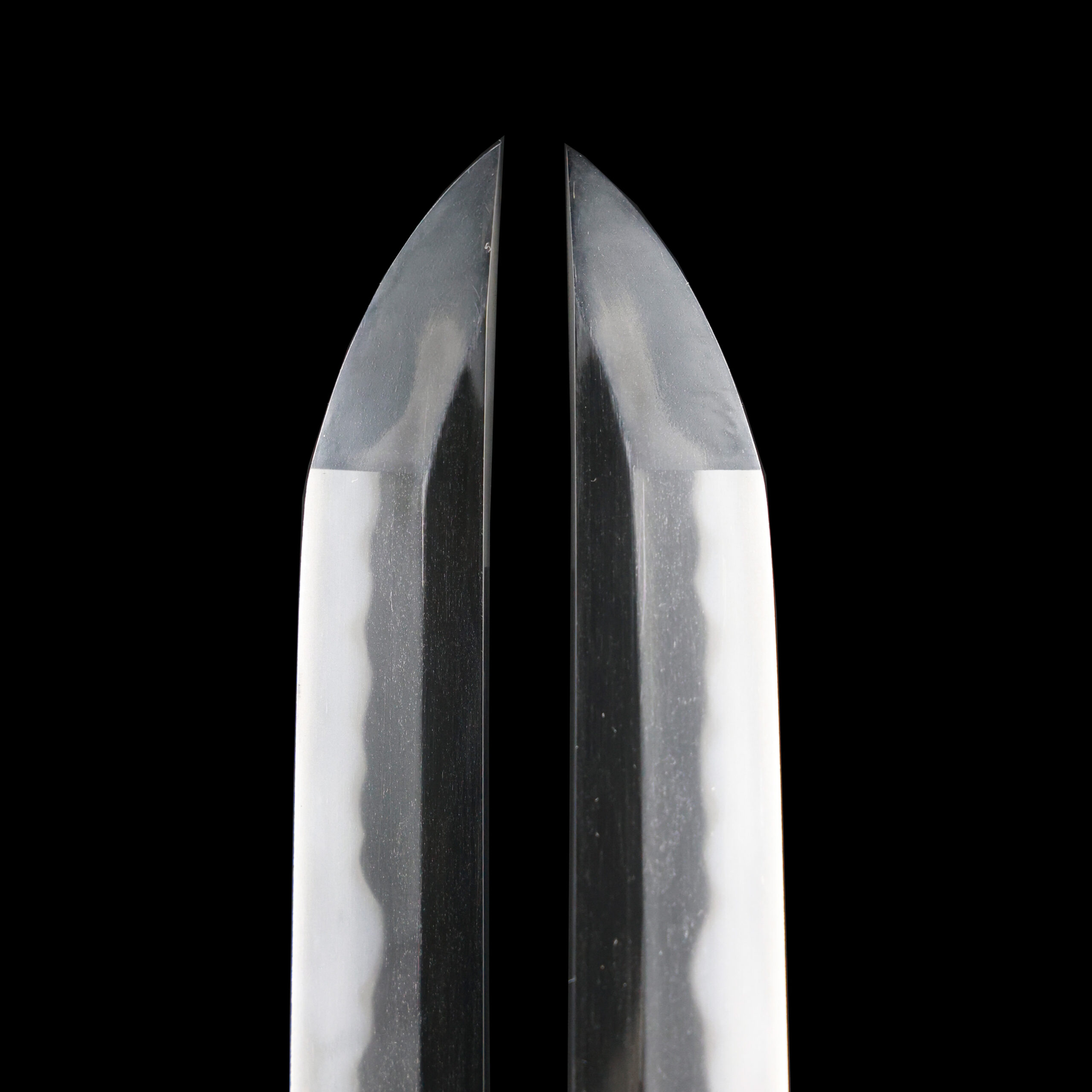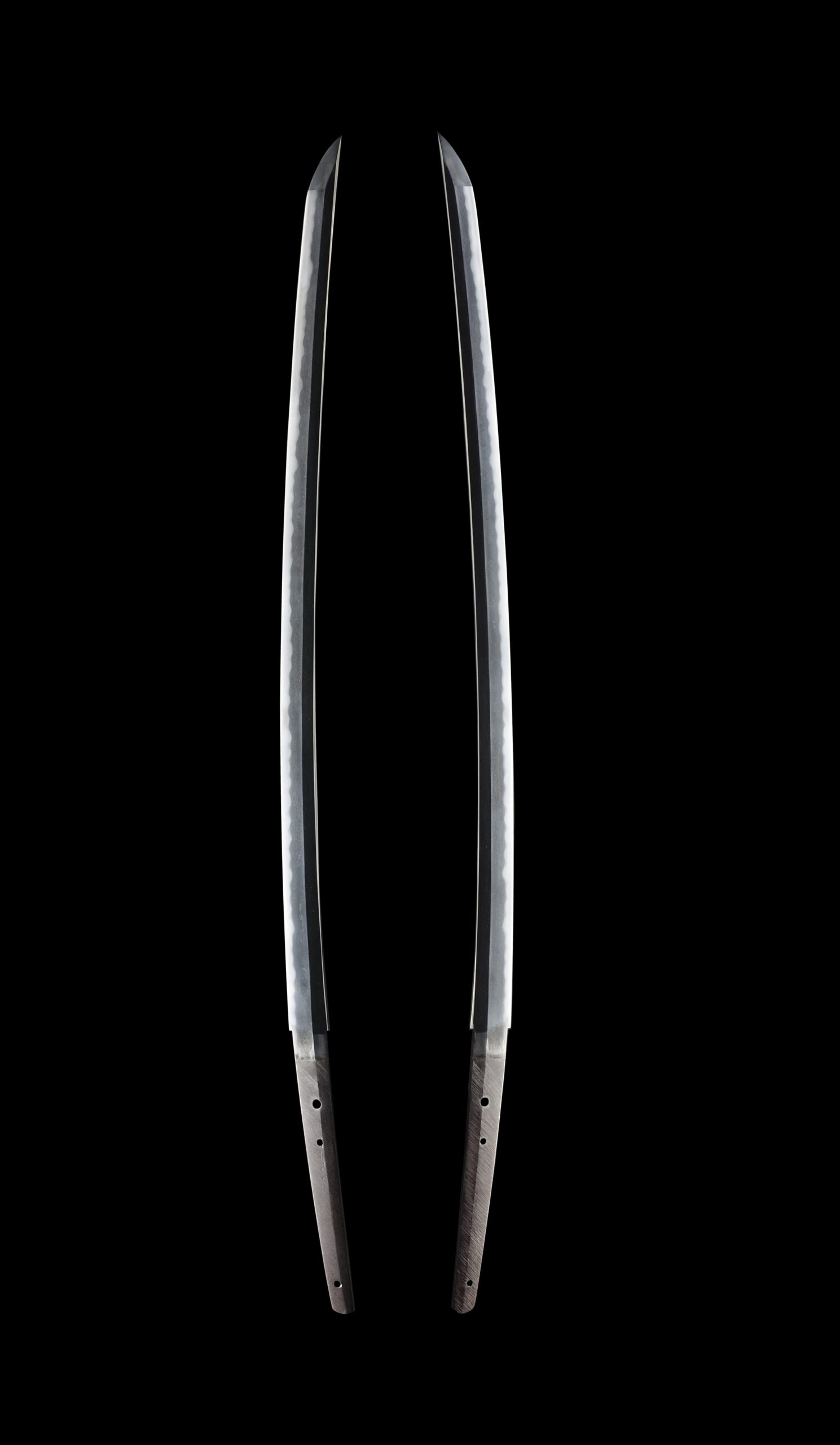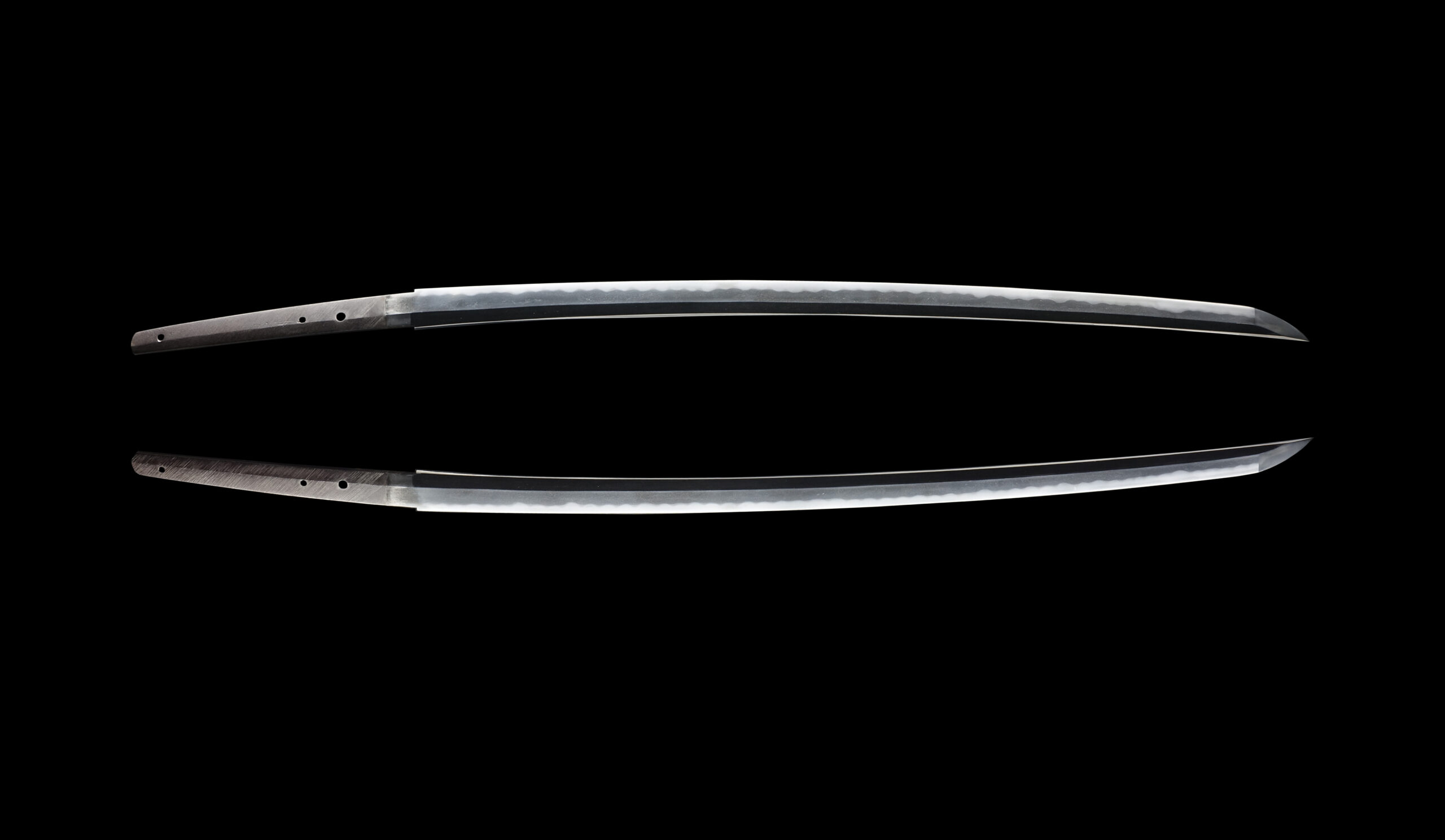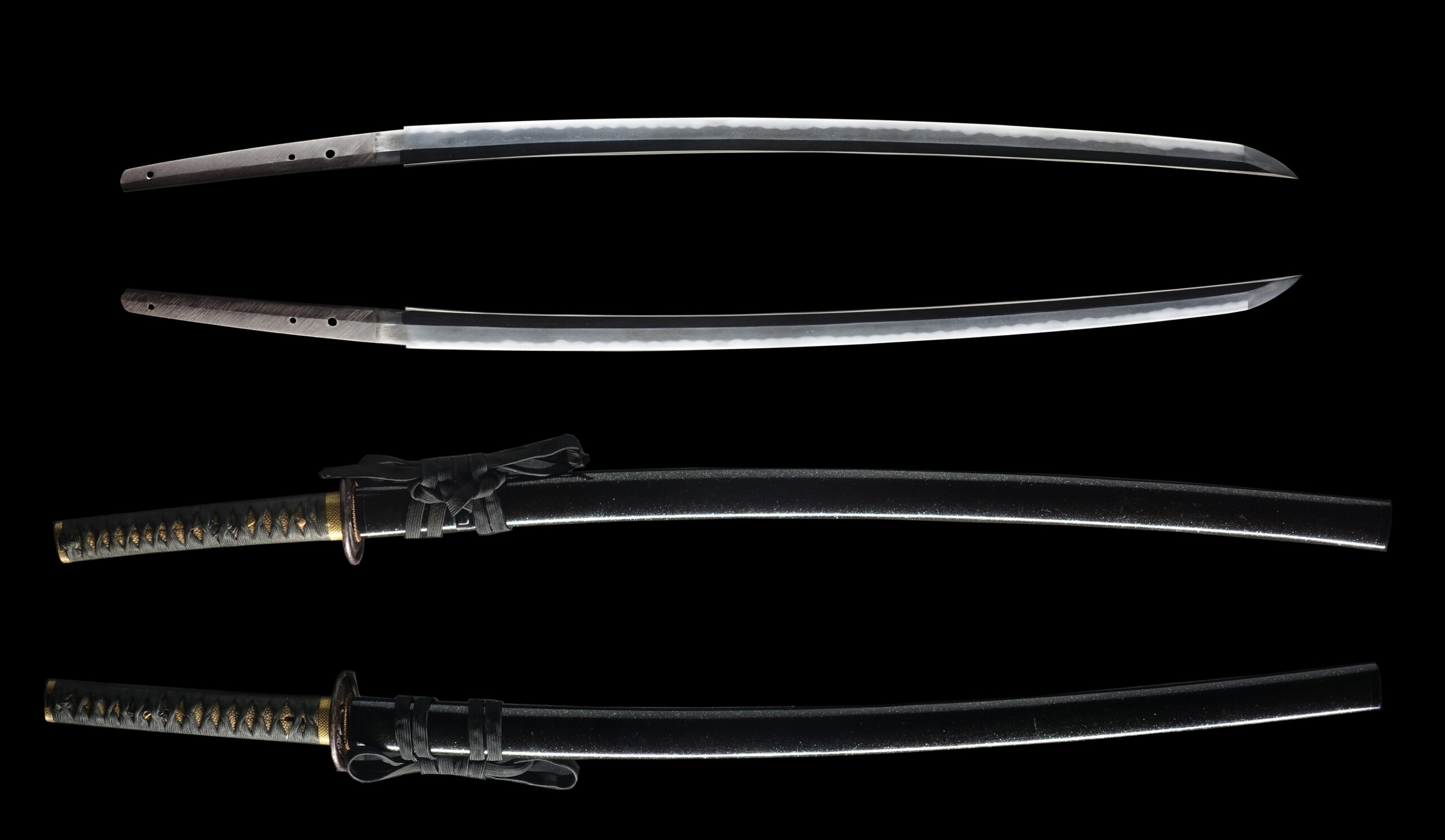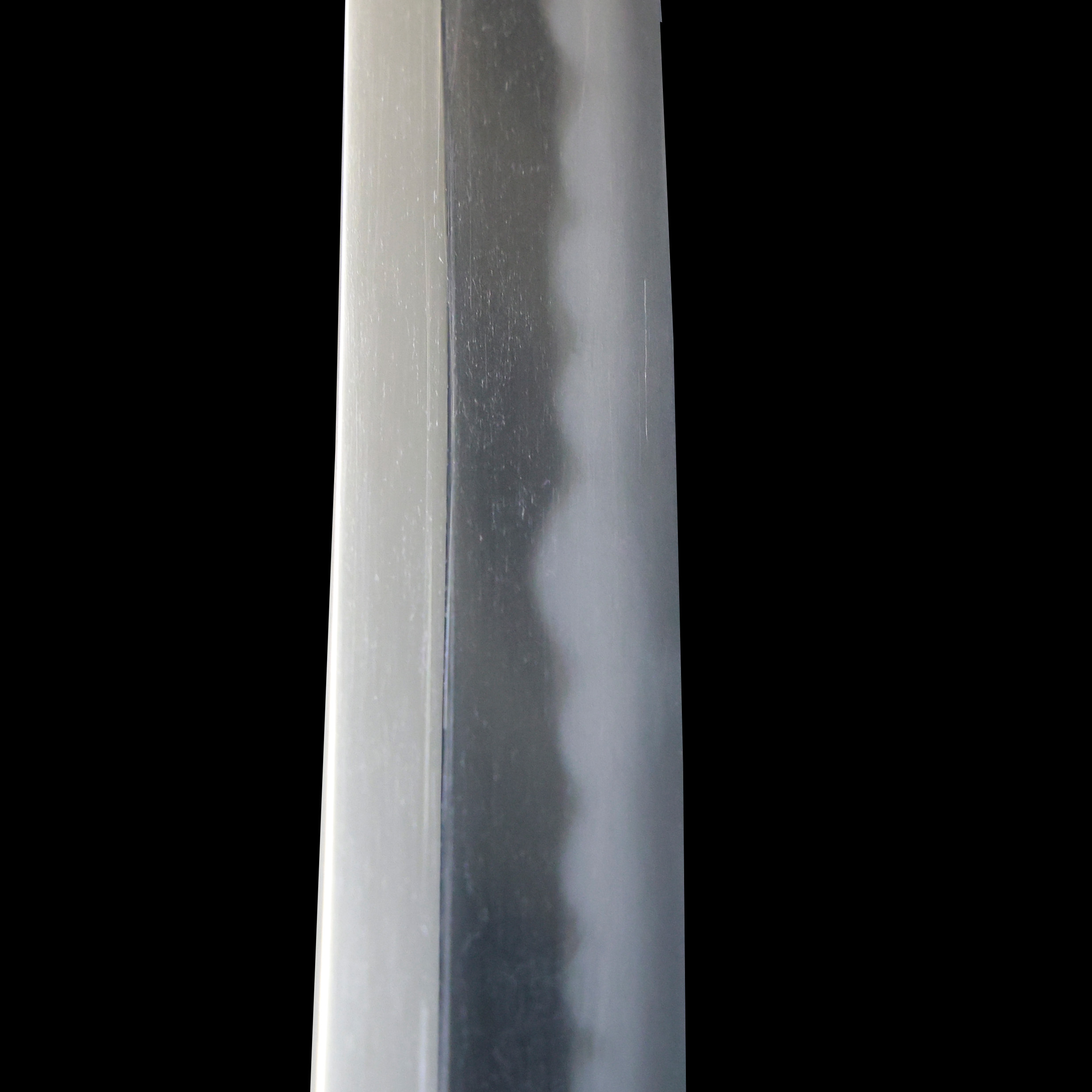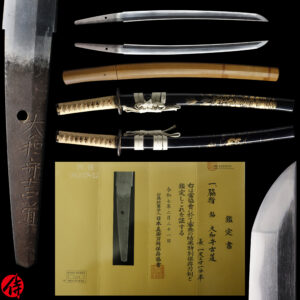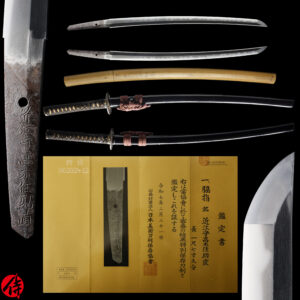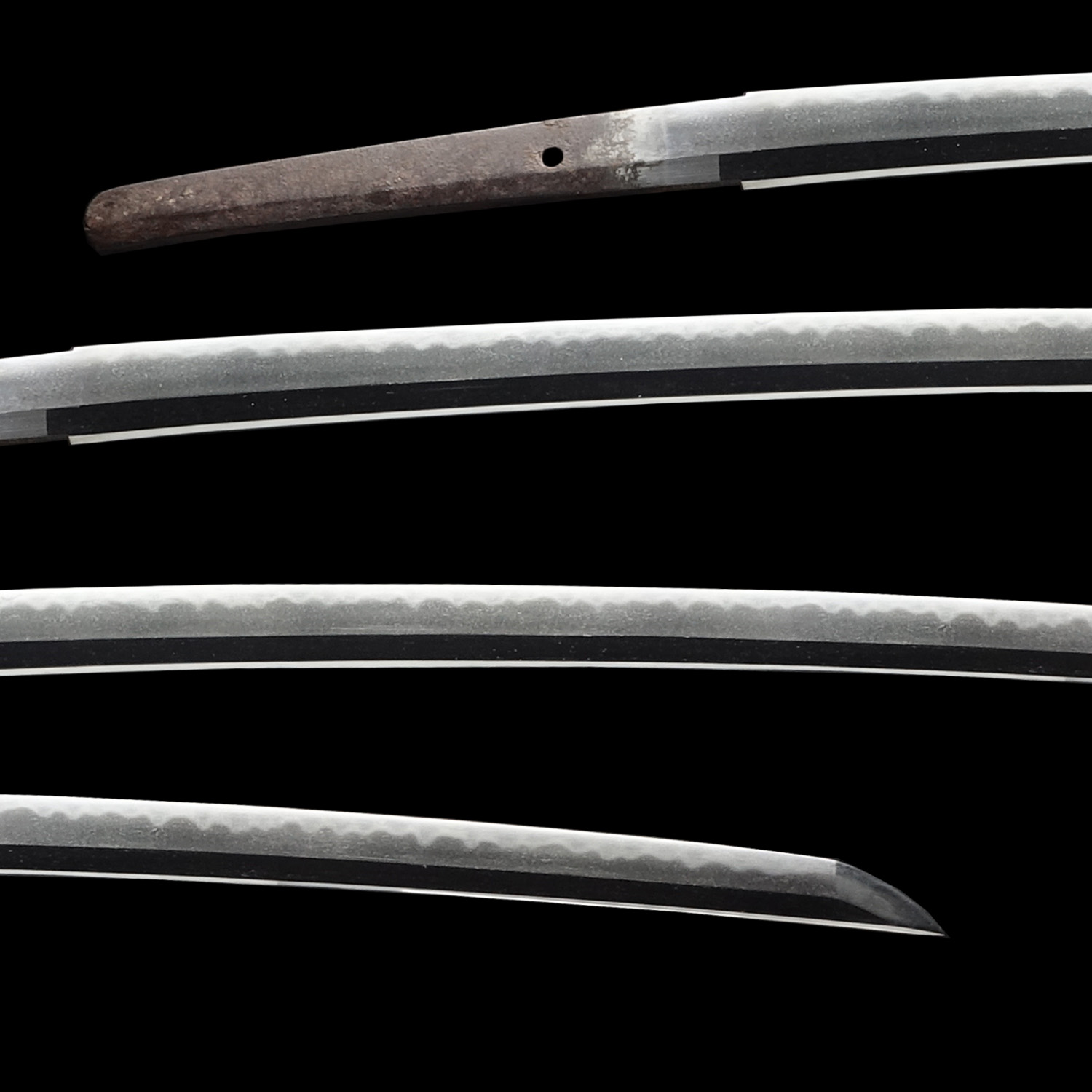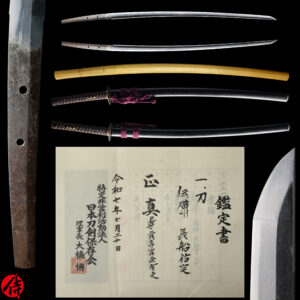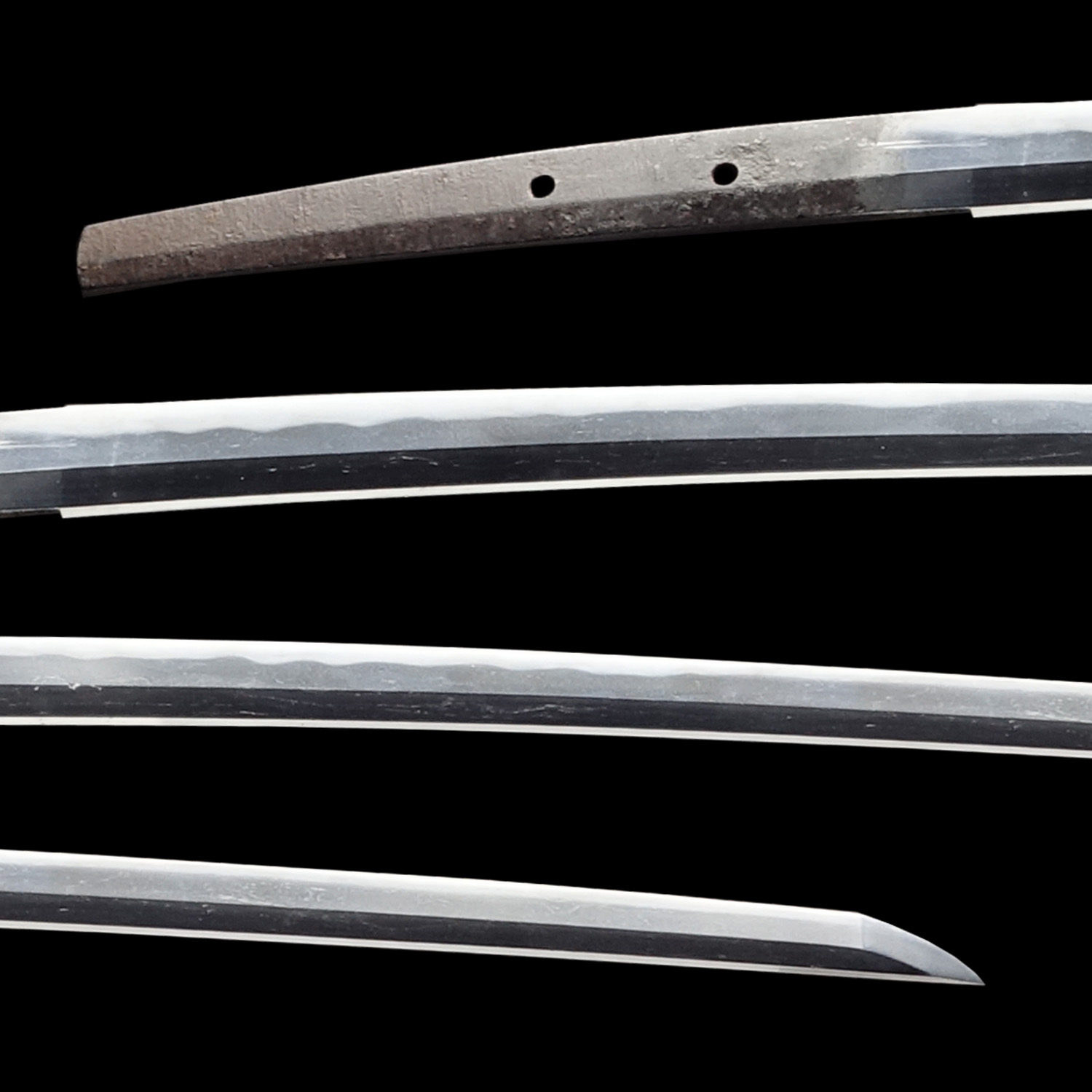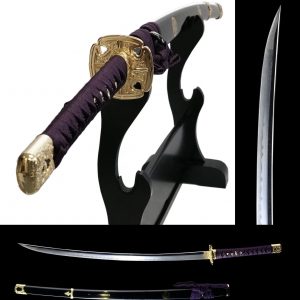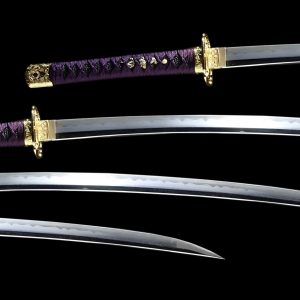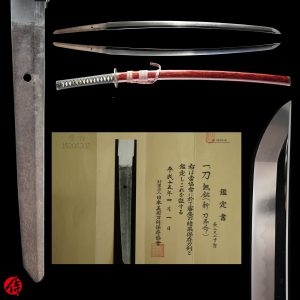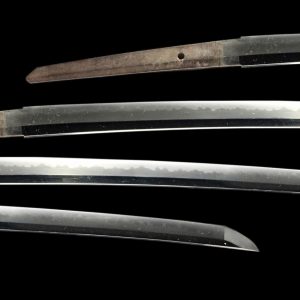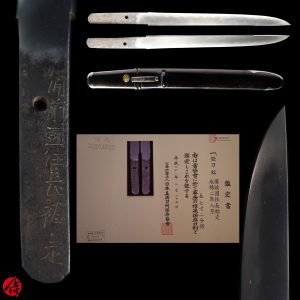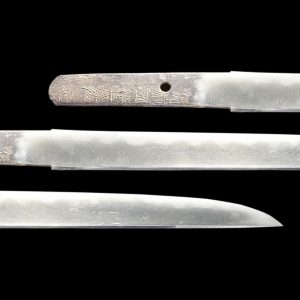Antique Japanese Sword Katana Attributed to Kasama Shigetsugu with NBTHK Kicho Certificate
【Description】
This blade is attributed to Kasama Shigetsugu (笠間繁継). Shigetsugu was born in Shizuoka Prefecture in the 18th year of the Meiji era (1885). He was an apprentice of Morioka Masayoshi, his uncle. He also worked under the name Kasama Ikkansai Shigetsugu (笠間一貫斎繁継) while his birthname was Kasama Yoshikazu (笠間義一).
In 1903, when he was late teens, he moved to Tokyo. Later on, he become one of the masters of Nihonto Denshusho. Nihonto Denshusho is a Japanese Sword Training Institute dedicated to preserving and teaching the traditional techniques of Japanese sword-making (nihonto). Established in 1926 by renowned swordsmiths such as Kurihara Akihide (栗原昭秀) and others, the institute was created in response to declining interest in traditional sword-making during the Taisho and early Showa eras. Its goal was to train a new generation of craftsmen in the ancient art of forging, polishing, and appraising Japanese swords. After teaching his sword-forging techniques there, he became the head master of another institution called Tozan Teinai Tokiwa Matsu Token Kenkyujo, which served for the same purpose of Nihonto Denshusho.
He was a Kunaisho Toko (宮内省刀工), which means that he served the Ministry of the Imperial Household as a swordsmith. He also received multiple awards during his career. It is said that he dedicated his career to preserving the tradition of Japanese sword making.
Given that he was the teacher of Shohei Miyaeri (宮入昭平), who was a Living National Treasure in Japan, and that he was appointed to the position of Sword Specialist at the Imperial Household Agency, it can be inferred that his remarkable craftsmanship was highly appreciated.
*Please keep in mind that there are a couple of Kitae Kizu on this blade. If you like to know the detailed condition, please feel free to contact us.
【Blade】
Cutting Edge Length(Nagasa):68.4 cm (26.9 inches)
Curvature(Sori):1.6 cm (0.62 inches)

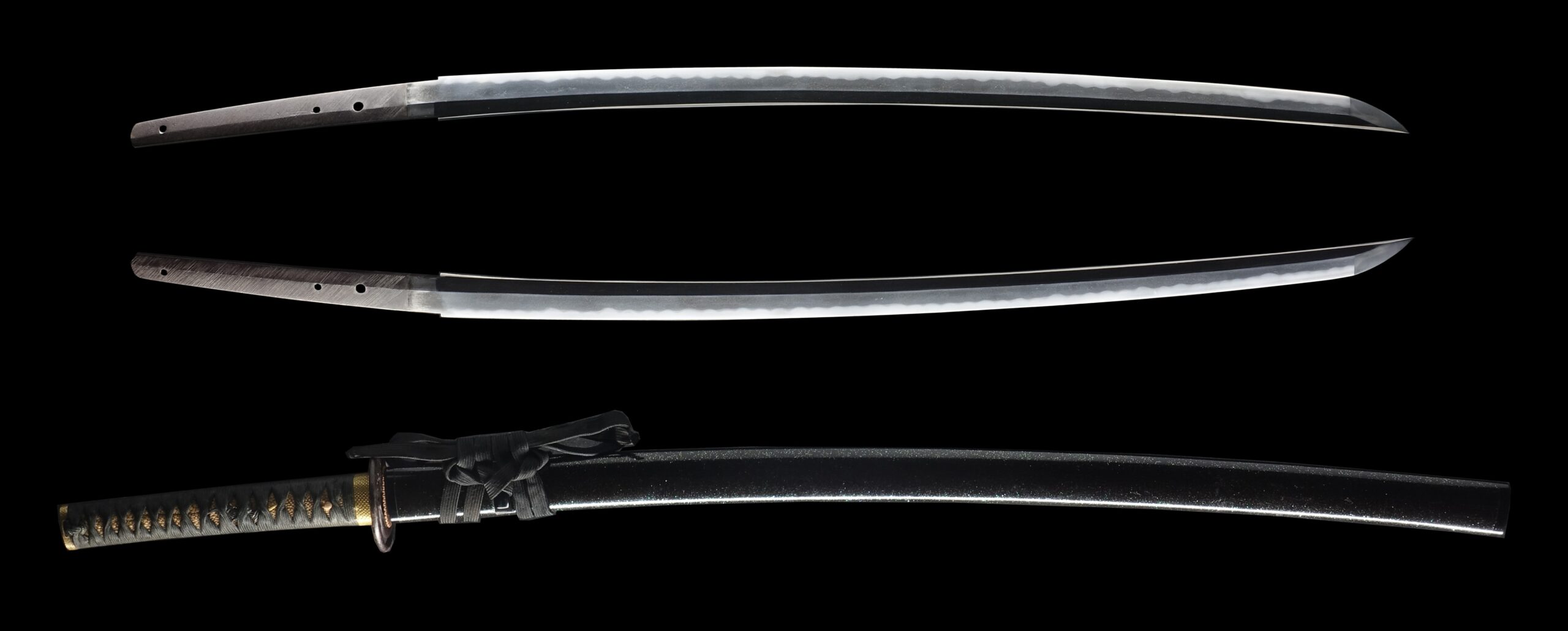
Hamon:
The crystalline structure which forms along the cutting edge of a blade as a result of the hardening process
Jimon(Jihada):
visible steel surface pattern created by folding and hammering during forging process

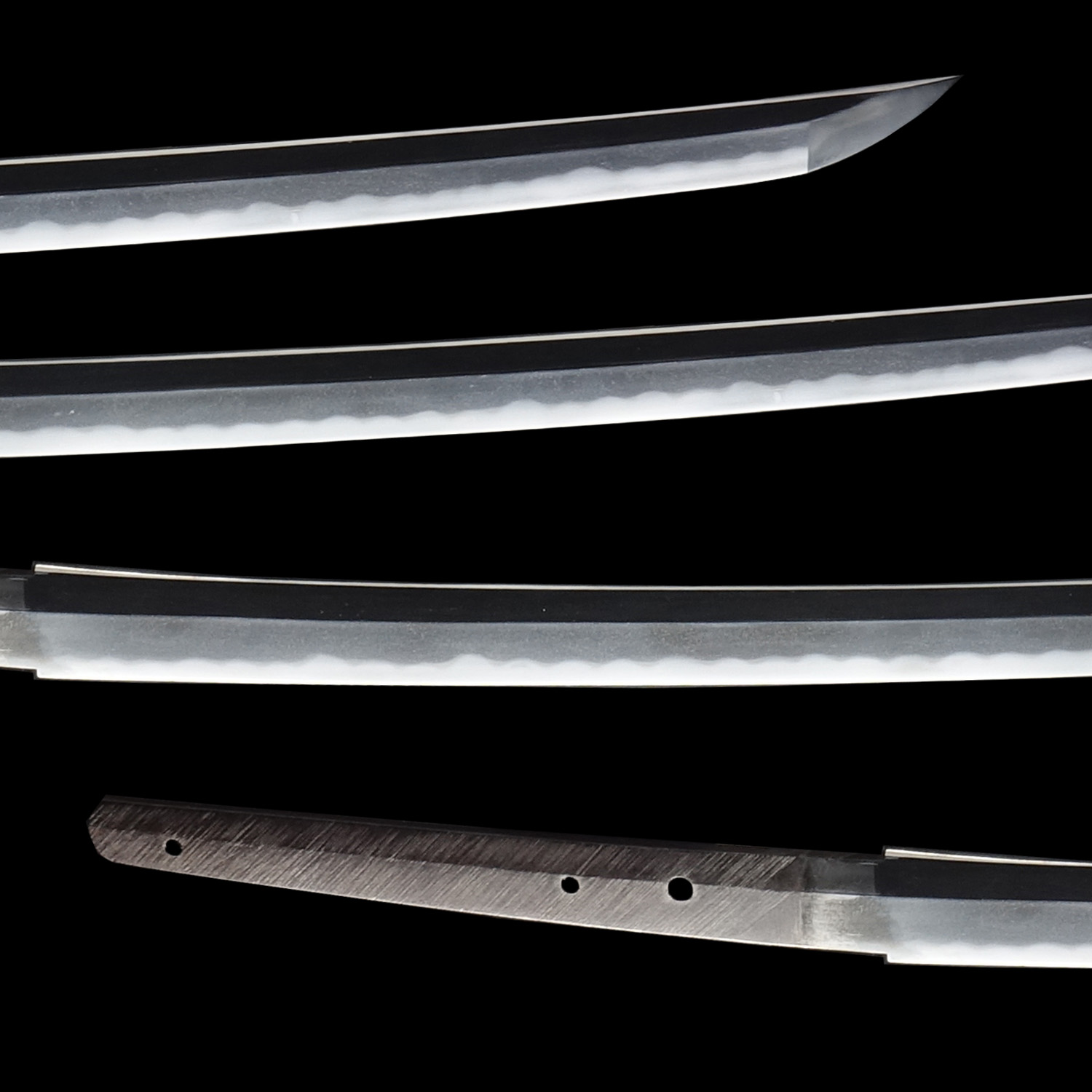
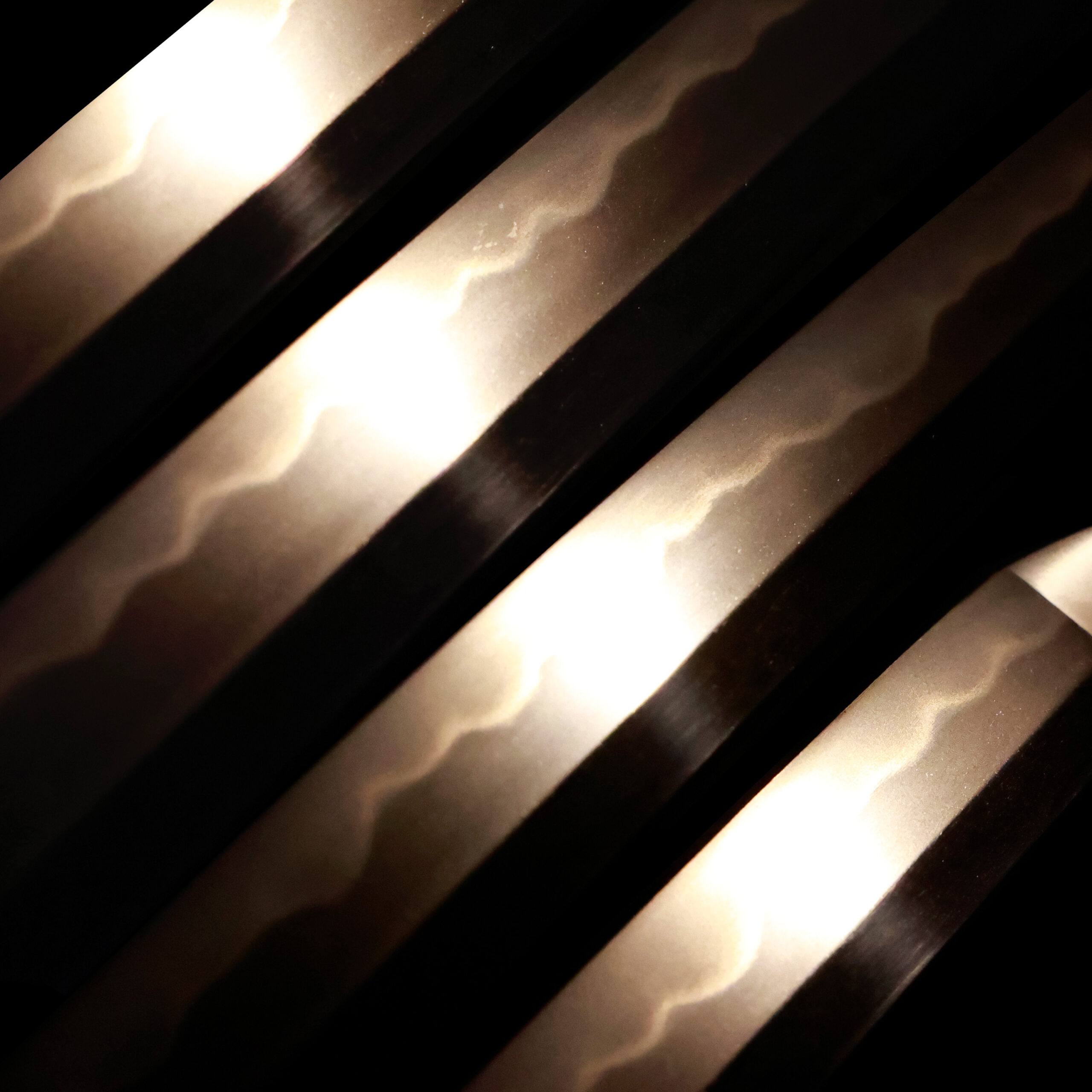
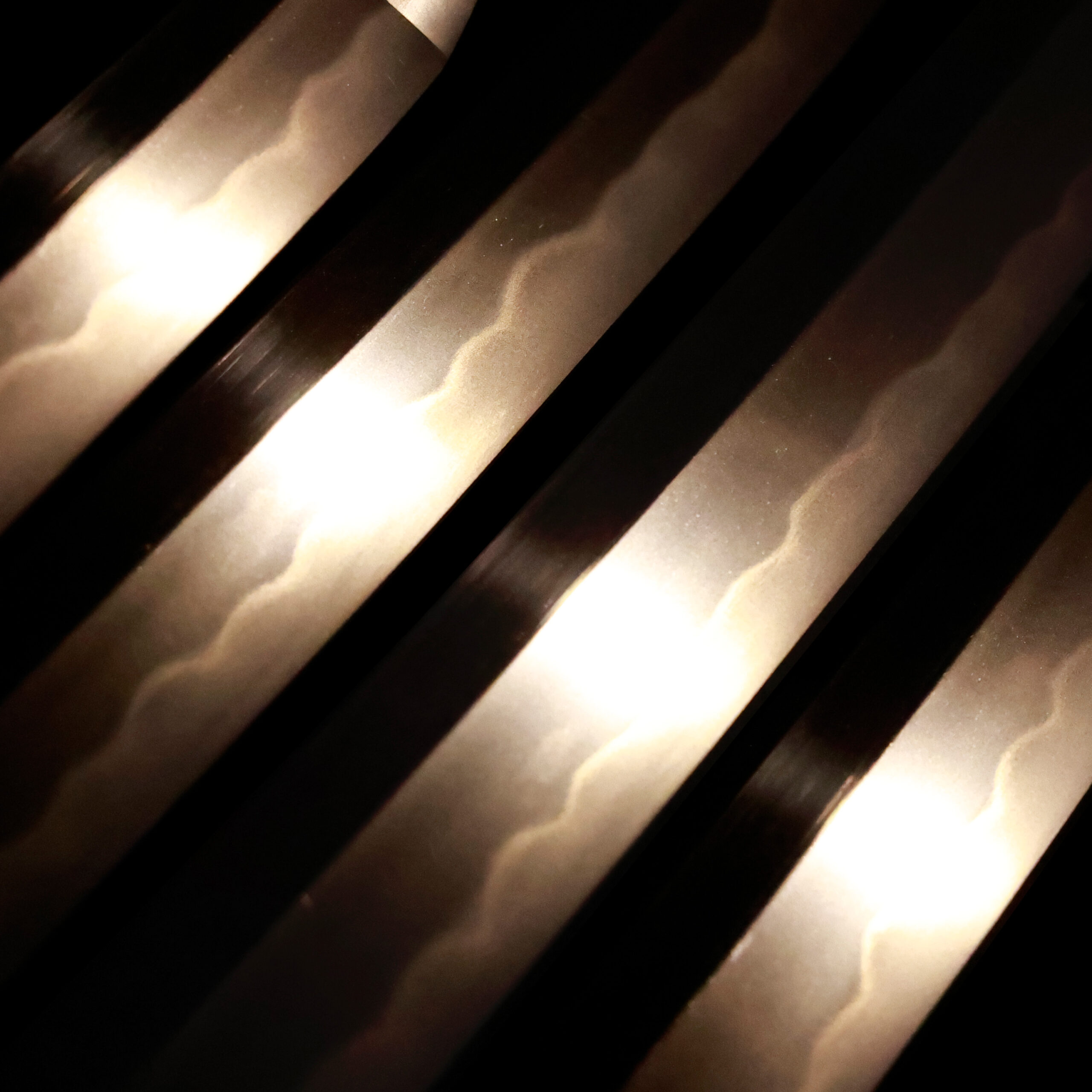
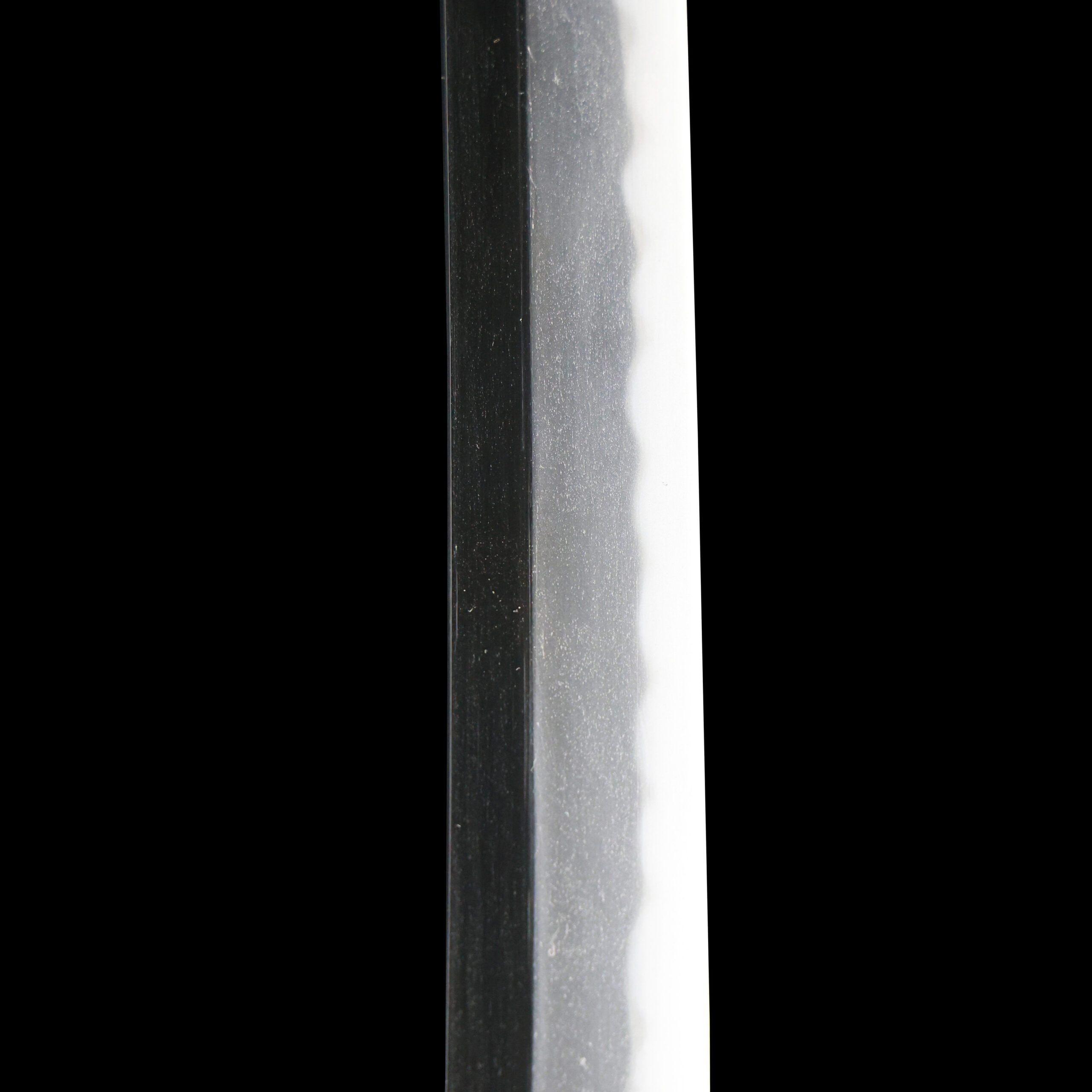
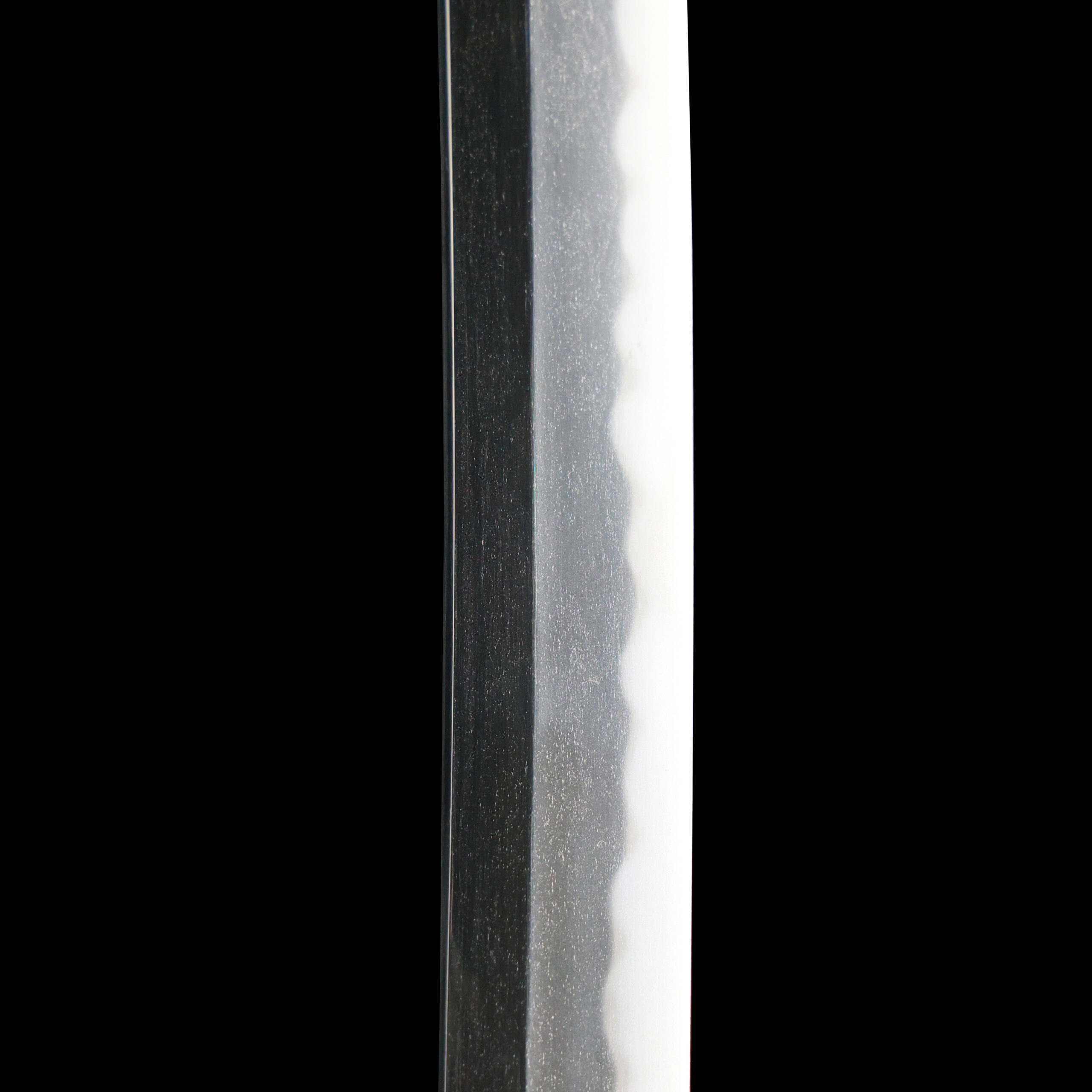
Kissaki:Kissaki is the tip of the Japanese sword.
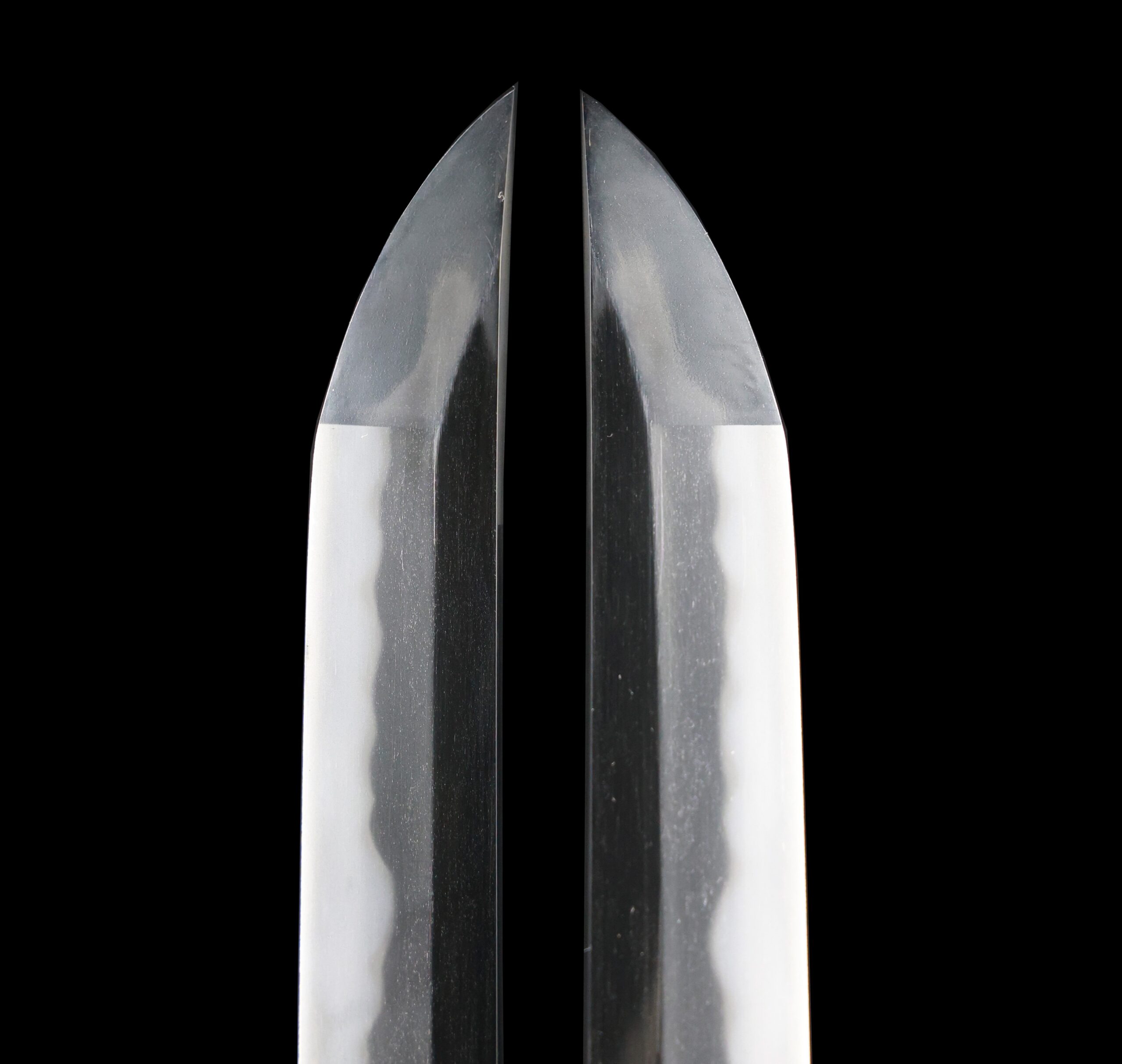
Nakago:Nakago is the tang of the Japanese sword.
Japanese swordsmiths left the black rust on the tang because it prevents red rust while the tang is in its handle. And the discoloration of the tang was created over time, and it is a great indicator for a Japanese sword specialist to estimate when the sword was forged.
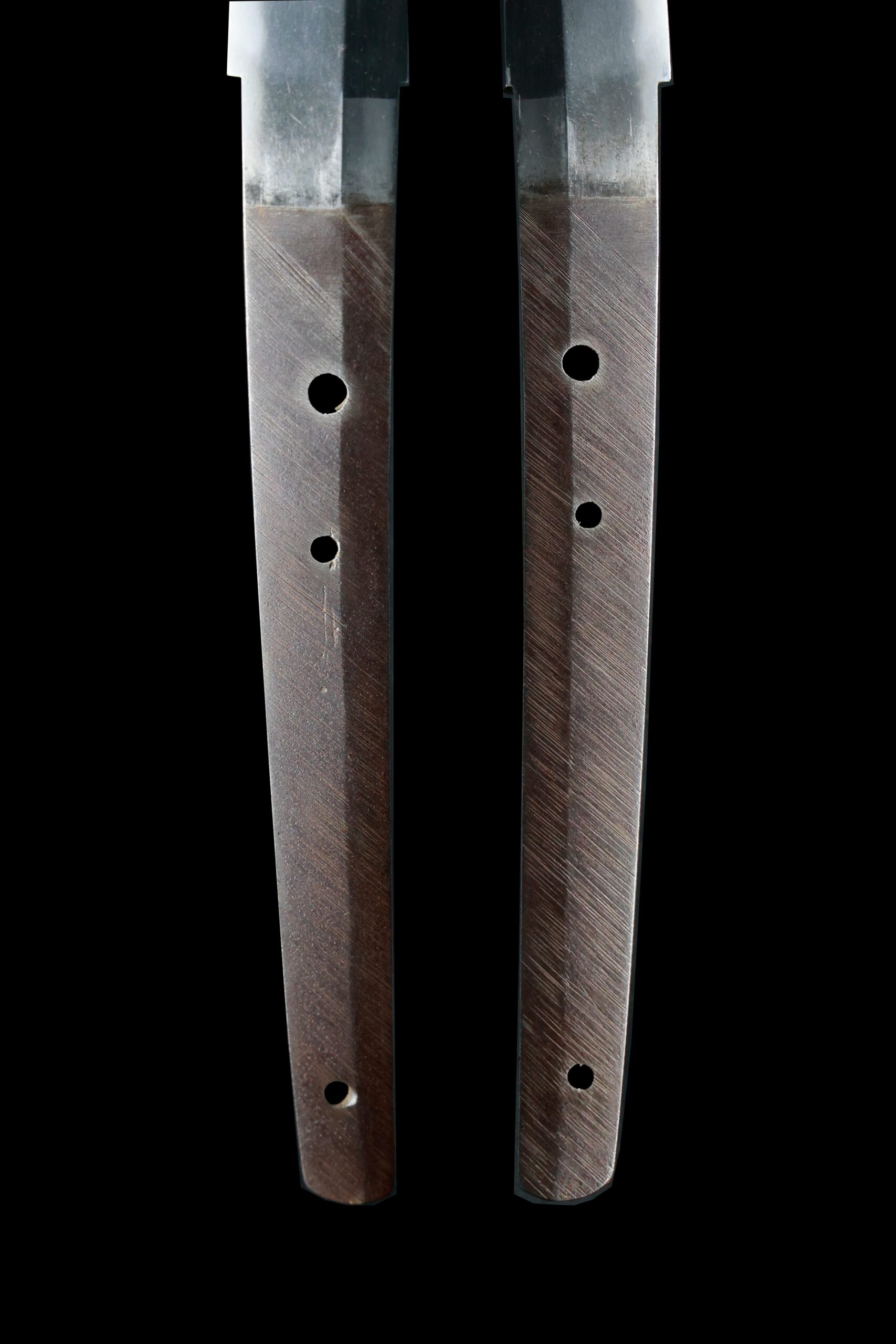
Koshirae:Koshirae is the mounting of the Japanese sword. There are several parts that consist of Koshirae such as Saya (Scabbard), Tsuka (Handle), Tsuba (Handguard).
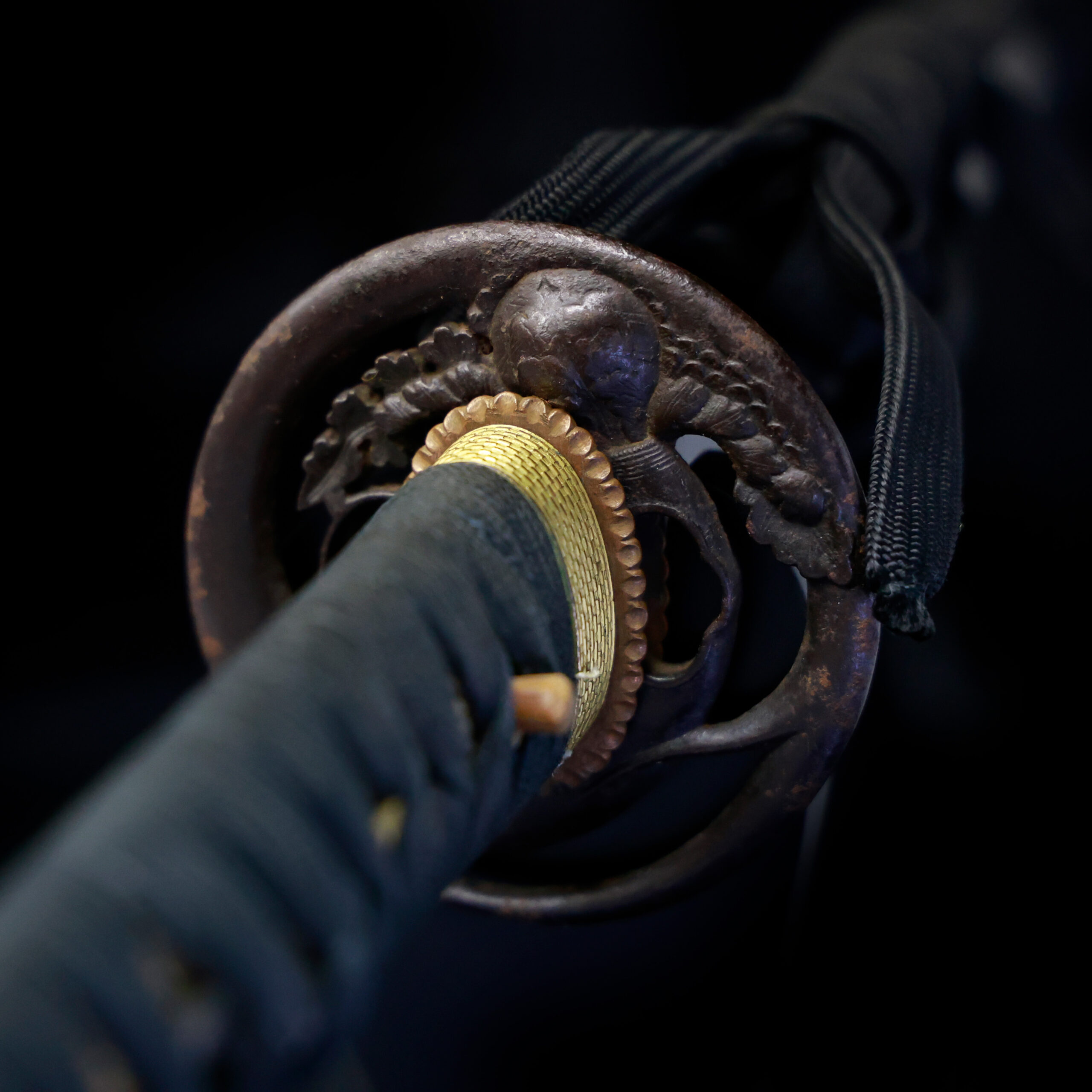
Fuchi-Kashira:A pair of matching sword fittings that cover the upper and bottom parts of its sword hilt.
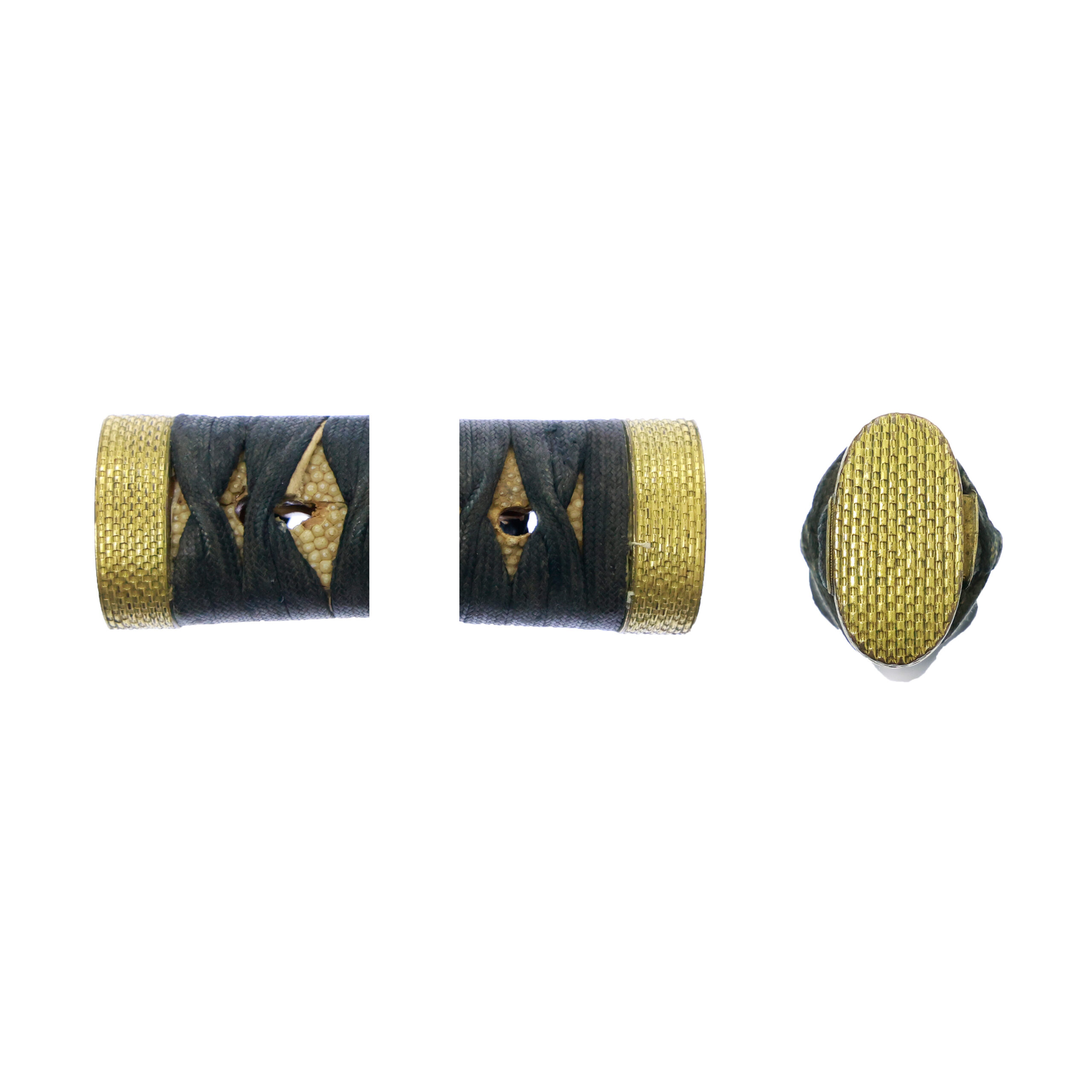
Tsuka and Menuki:Tsuka is the handle of the Japanese sword and Menuki is its decoration.
The motif of this Menuki is the combination of bats (蝙蝠, Koumori) and the moon (月: Tsuki). According to a theory, the continent largely influenced the introduction of bats as a pattern. This animal is a symbol of happiness and longevity. In the continent, it was popular as an auspicious pattern that brings good luck because its Japanese name letter “蝠” and another word “福 (happiness)” have the same sound. The design depicting five bats is called the Gofuku (五福) and symbolizes longevity, wealth, health, descendants, and prosperity.
The sun and the moon have been treated as objects of worship since ancient times. Some people considered them the symbol of authority. The moon pattern has various shapes depending on the waxing and waning of the moon: full moon, half-moon, crescent, or hazy moon. There is also the idea: as the moon changes its shape depending on its fullness, it represents growth and development. Moreover, the moon is a classic design that symbolizes autumn: the combination of a moon with rabbits, deer, autumn grass, waves, etcetera.
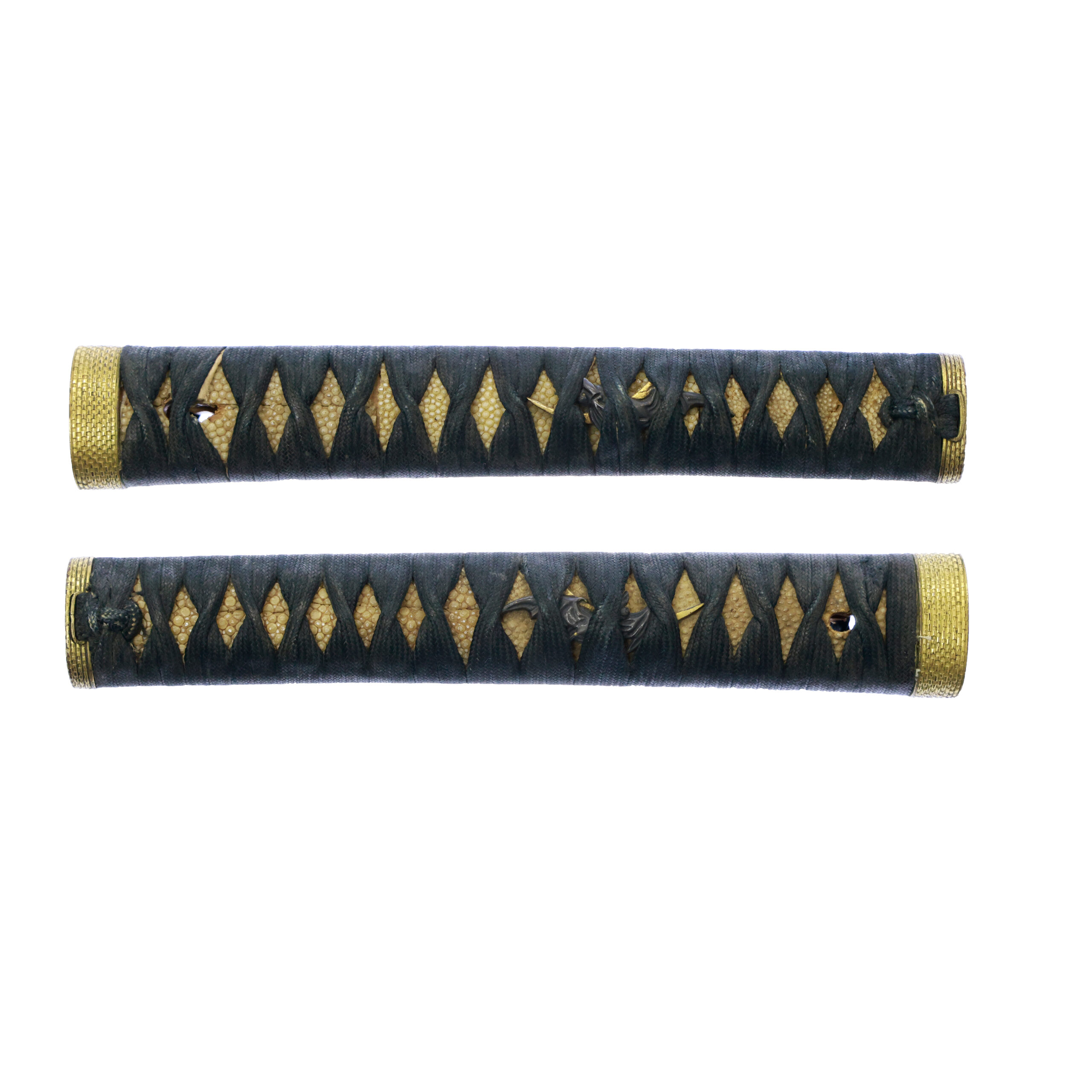

Tsuba and Habaki:Tsuba is the handguard for the Japanese Sword and Habaki is the equipment to make the blade not touch its scabbard inside. It prevents the blade from getting rusty and chipped.
The motif of this Tsuba is a turnip (蕪, Kabu). Kabu is one of the seven herbs of spring in Japan. People eat these herbs on January 7th, hoping for good health, and it is believed that it would protect people from evil spirits. And it is also said that the word “Kabu (蕪)” was said to be associated with the word “Kabu (頭, head)”, another pronunciation of Kashira (頭). Therefore, a turnip has been cherished as a food of good luck among Samurai families, who hoped to become the head or leader.
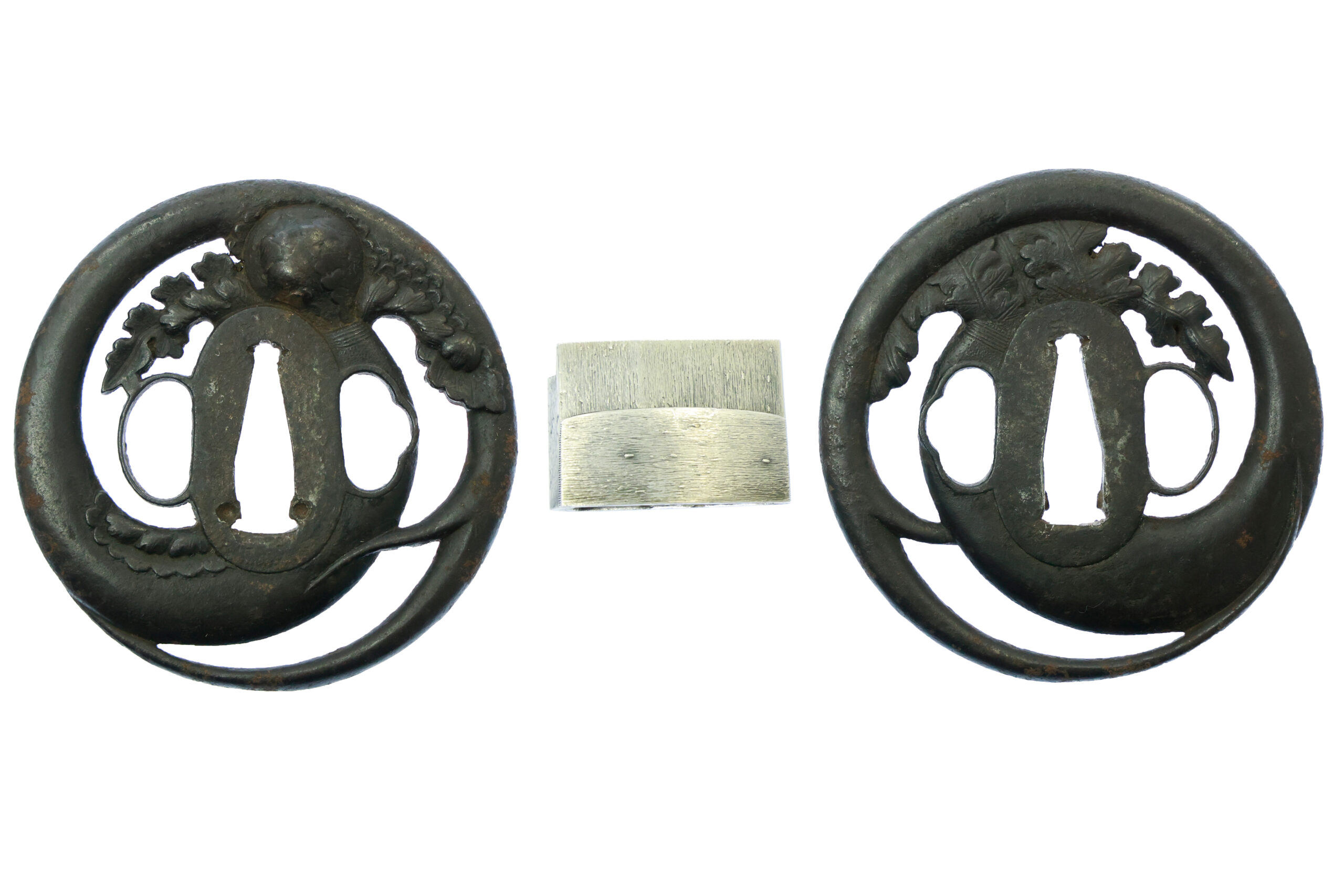
Saya: Saya is the scabbard for the Japanese sword.
This Saya is decorated with traditional Japanese craft method, the Raden (螺鈿: Raden). The Raden is a decorative technique that is often used for traditional craftwork. It uses the pearl part of seashells and puts it into the engraved surface of lacquer or wood. Thanks to its iridescent luster, it gives a luxurious look to works.

Authentication Paper:NBTHK Kicho Certificate for the blade (No. 283549)
NBTHK, also known as Nihon Bijutsu Touken Hozon Kyokai (the Society for the Preservation of the Japan Art Sword), is one of the oldest Japanese sword appraising organizations in modern-day Japan. They authenticated the blade on April 28th in the 48th year of Showa (1973). They appraised it as a Kiho Touken, an old form of the certificate. The purchaser will receive the original certificate as well. We can also translate what is written into English and make a PDF file for your record if you request.
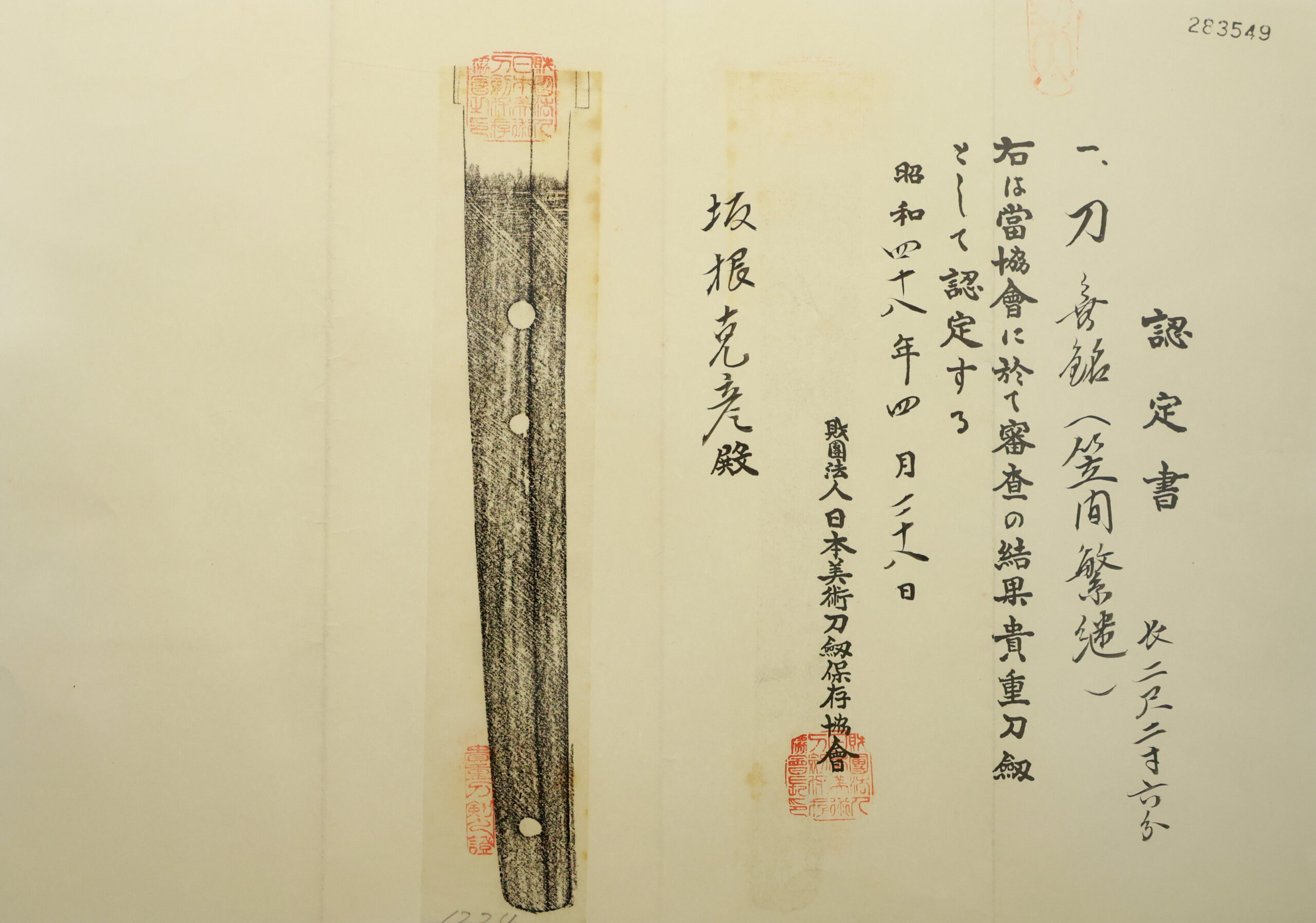
Registration Number : Fukuoka 107160
The Board of Education in Fukuoka prefecture issued a registration paper for this sword. It is called Jyu Hou Token Rui Tourokusho (銃砲刀剣類登録証). Bunkacho (The Agency for Cultural Affairs) acknowledges a Japanese sword with this paper as a work of art.
The sword needs to be traditionally hand-forged and made of Tamahagane carbon steel to be registered in the system. With this paper, its owner in Japan can legally own an authentic Japanese sword. Based on this registration number, we will apply for its export permit.
This paper will need to be returned to the board of education when the sword is being shipped abroad, but you can receive a copy of it. An English translation of this registration paper is available on request.
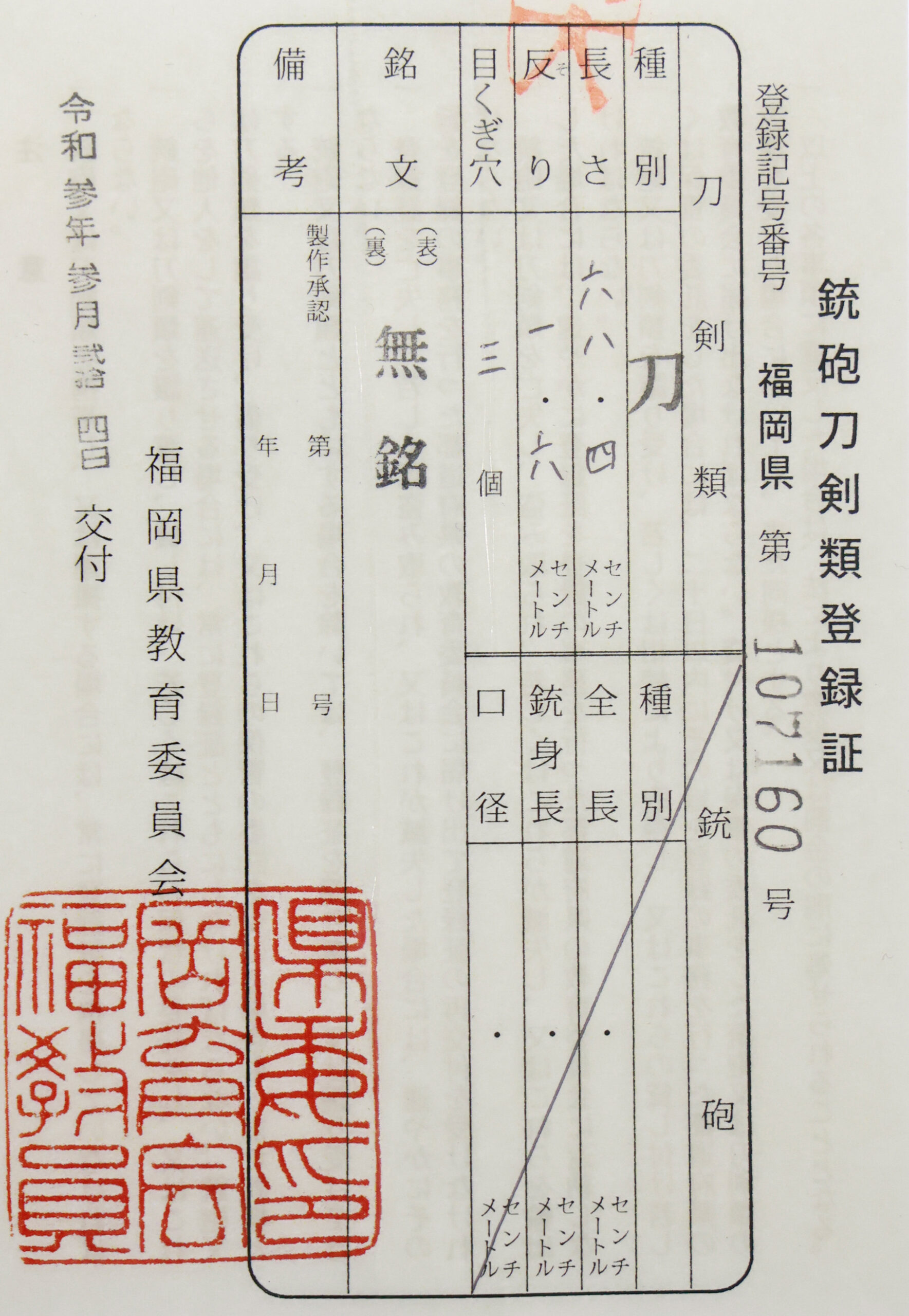
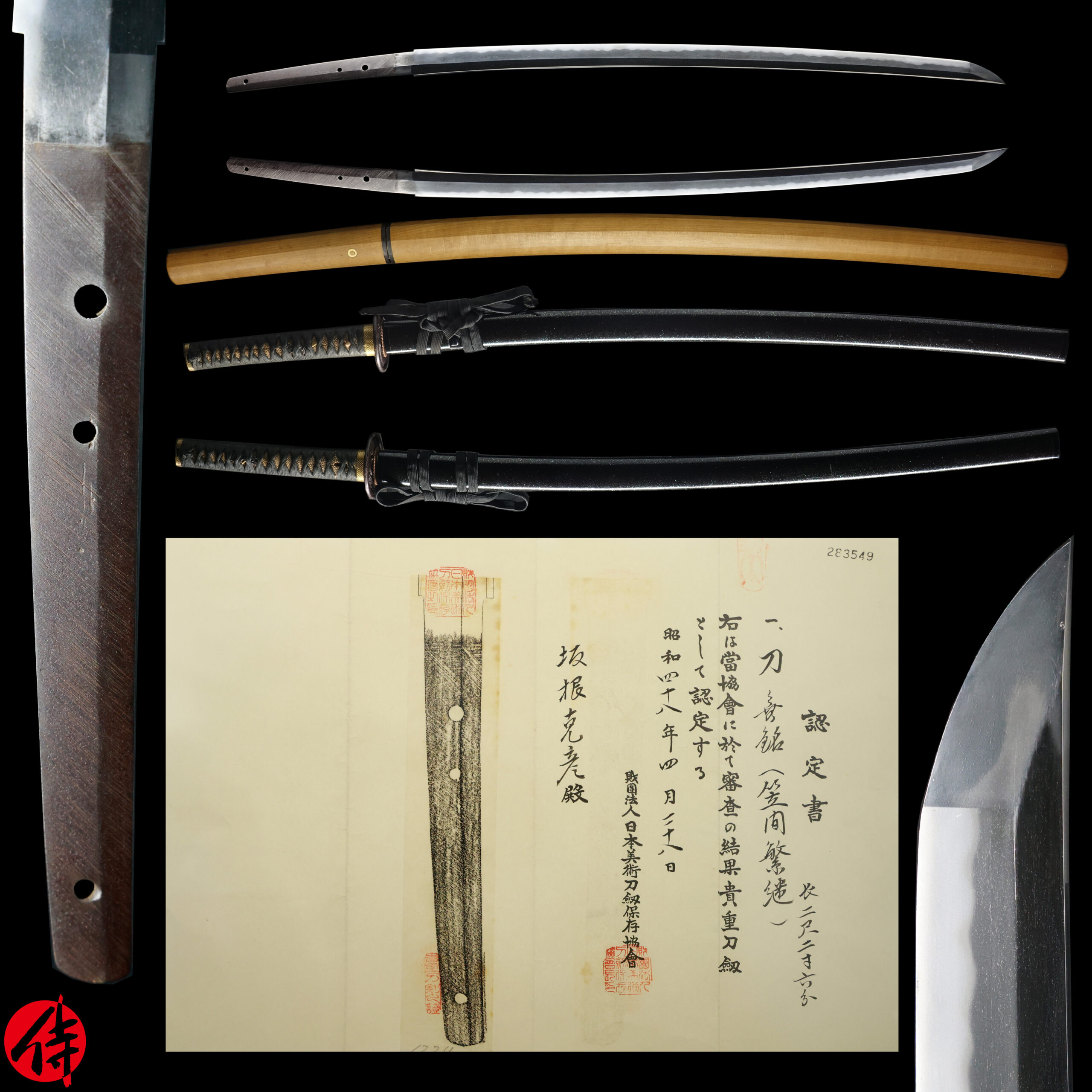
—————————————————————–
【About us】
Samurai Museum is located in Tokyo, Japan, exhibiting antique artifacts related to the Samurai history. Samurai Museum Shop is the place for those who are interested in Japanese culture and craftsmanship. We deal with antique Samurai swords/armor, traditional crafts made in Japan and so on.
【Japanese Sword& Export Process】
The Japanese swords we deal with are hand-forged edged swords made in Japan. It was made from the traditional carbon steel called TAMAHAGANE(玉鋼). Samurai Museum is familiar with the proper legal procedure for an antique/ authentic Japanese sword to be exported from Japan. We have sent more than 1000 Japanese swords for the past few years (~2025) to amazing owners who appreciate its historical value.
Each Japanese sword is registered under the Agency for Cultural Affairs and the Board of Education in Japan. They issue a registration paper for each Japanese sword for its owner in Japan to legally possess it. The Japanese sword with its registration paper means it was traditionally hand-forged in Japan.
To legally export the sword from Japan to other countries, we will have to apply for its permit to the Agency for Cultural Affairs(Bunkacho) and return the original registration paper to the Board of Education. It normally takes around 2-4 weeks to receive this permit after submitting required documents. And we would like you to expect at least 1-1.5 months for your order to arrive at your given address after you ordered. For more detailed info, please click here.
It is allowed for residents in Japan to own authentic Japanese swords without a special license as long as they come with registration papers. Please feel free to contact us if you are a resident of Japan, whether temporarily or permanently. We will also assist you when you leave Japan and need to obtain the export permit.
【Payment Method】
We accept payment through Stripe (Credit card), PayPal, Apple Pay or ChromePay, all of which are secure payment methods. Also, you don’t need to make an account on Stripe for the checkout. If you prefer other payment method, please contact us. After confirming your payment, we will apply for an export permit. You may either pay in JPY, USD, AUD, CAD,EUR CHF or GBP. The price is set in Japanese Yen. Prices in other currencies are automatically calculated based on the latest exchange rate.

* If the amount is above 1 million JPY, Stripe or wire transfer will be the only options for payment.
【Shipping】
We have shipped authentic Japanese swords to the USA, Canada, Mexico, Germany , Belgium, France, Finland, UK, Hong Kong, Australia. If you don’t live in these countries and like to order, please contact us first before making a purchase. We offer Free International Shipping as long as we can send antique Japanese swords by EMS.
We normally ship by EMS(Express Mail Service) provided by Japan Post. We will send you a tracking number for your order as soon as we hand it to the post office. We will put 100 % insurance on the shipping document without any extra charge. Based on the total amount, there might be a duty tax or other fee for you to pay, depending on the countries. We use package cushioning to protect the item and put it in a PVC pipe, which is one of the most secure packages because of its durability.
It will normally takes 5-14 days for the item to arrive at your given address after we dispatch it. Time of delivery is estimated as accurately as possible by the carrier but does not take into account any delays beyond our control such as by inclement weather, post office holiday seasons.
* If you live in Australia and like to purchase an authentic Japanese sword, please click here to know the detail.
* If you live in the UK and like to purchase an authentic Japanese sword, please contact us first and click here to know the detail.

【Review】
Here is one of the reviews we received from a customer who purchased an authentic Japanese sword from us. For more reviews, please click here.
“My experience overall with the whole process was wonderful. I had many questions about the history and process to purchase these treasures. All my questions were answered very timely and complete. The staff is very knowledgeable and very well versed if any questions do arise.”
【How to make sure the condition】
Please keep in mind that what you are going to purchase is an antique item. We uploaded high resolution photos for you to check its condition thoroughly. If you like to see more photos with different angles, please feel free to contact us. We will be happy to send them to you so that you can make informed decision. It is essential for us to know that you are happy with your choice of a sword. and we are prepared to use the best of our ability to serve you.
【How To Contact Us】
Please contact us through email, Facebook Messenger or Live Chat if you have any questions. You can find each icon on the right side of the website. Please click one of them to reach us. We will reply to you within 1-2 business days.
【The Art of Nihonto (Japanese Sword)】
Samurai’s history is a profound, eloquent legacy of ancient Japanese warriors in which millions of people worldwide are being fascinated. If you like to find out the art of Nihonto, please click here.
【A Guide to Japanese Sword Maintenance】
After acquiring an genuine Japanese sword, it is also important to know how to take good care of it. Here is the special video for you. Mr. Paul Martin, Japanese sword expert, shows you how to give proper maintenance to your sword. By mastering how to clean the Japanese sword, its aesthetic beauty will last forever.
When you purchase a Japanese sword from us, you can get a Free Japanese sword maintenance kit. It comes with four tools(Choji Oil, Uchiko Whetstone Powder, Peg remover, Oil Applicator). By watching the video instruction above , you can enjoy learning how to maintain your Japanese sword while appreciating it. If you have any difficulty assembling the sword or cleaning the blade, you can feel free to contact us.
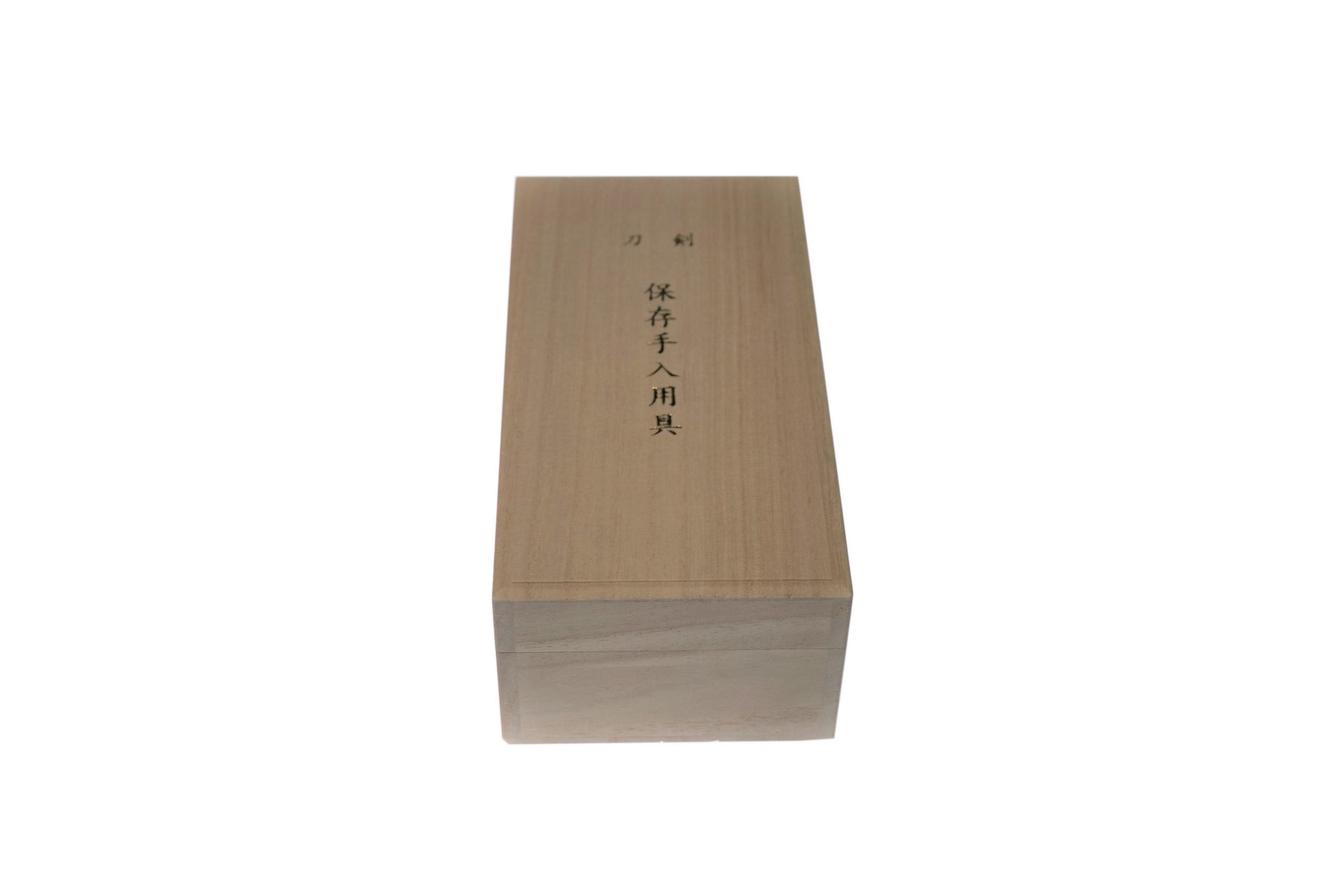
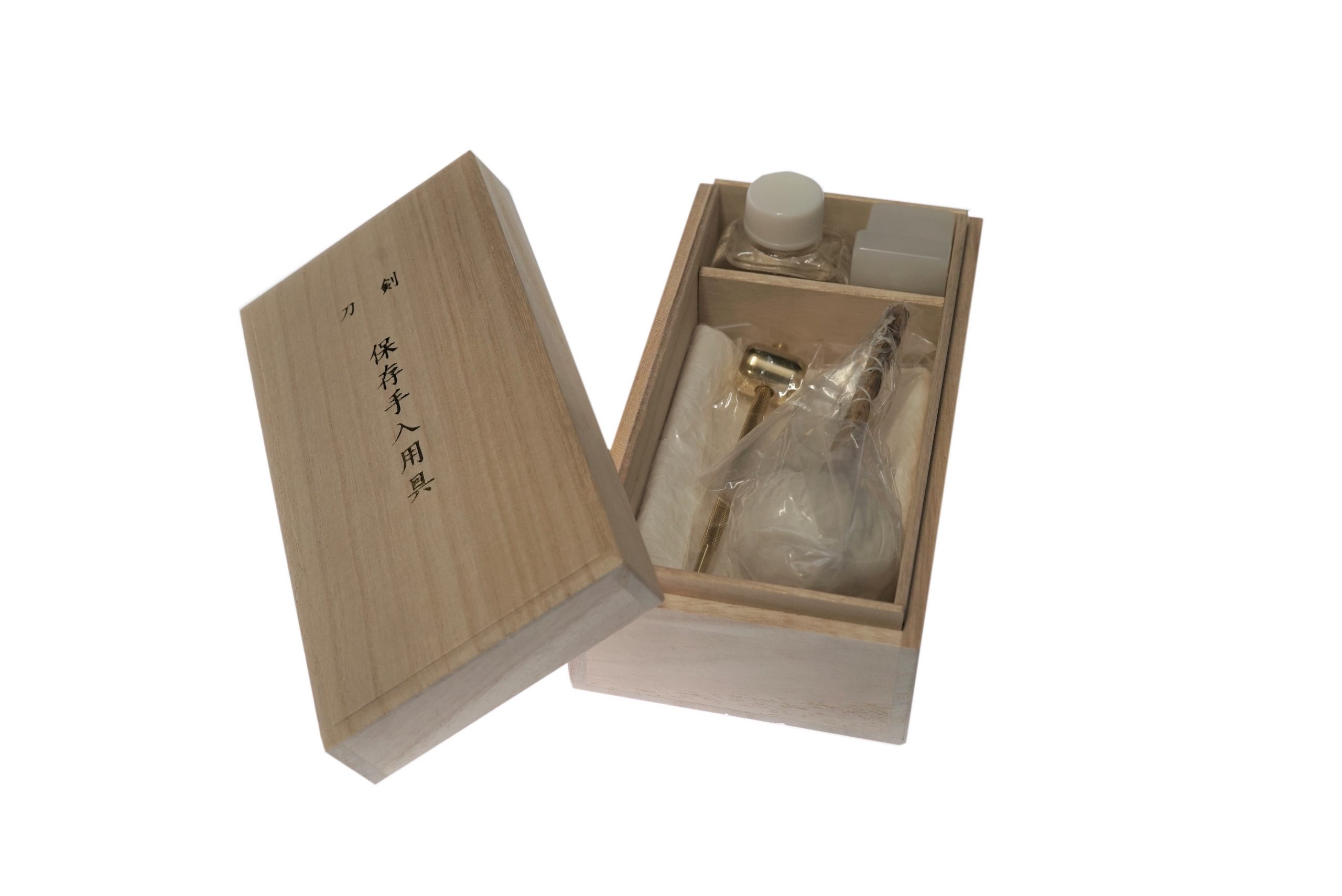
MORE ANTIQUE JAPANESE SWORD FOR SALE
SWORDS WITHOUT CERTIFICATES FOR SALE
LEARN JAPANESE SWORD TERMINOLOGY
Thank you for reading all the information on the page. If you have any difficulty choosing the right Japanese sword for you, we will be more than happy to help you find the one that speaks to you the most. Please feel free to contact us.
